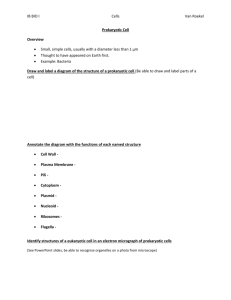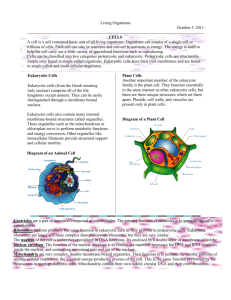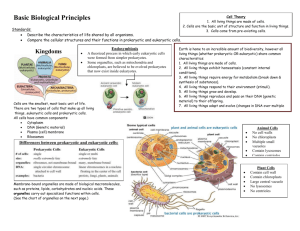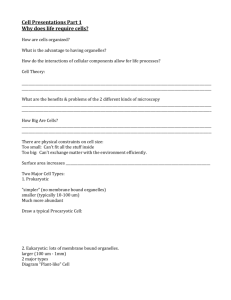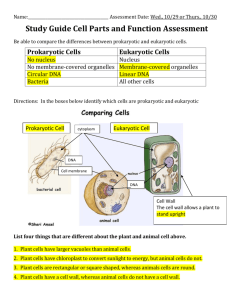File
advertisement
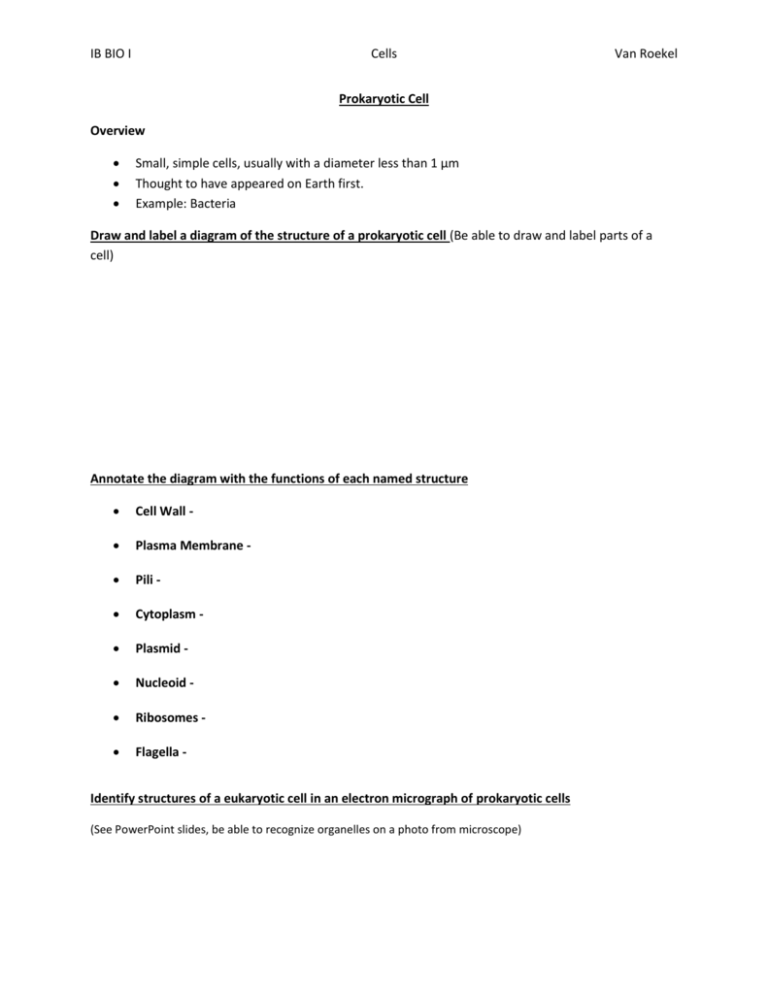
IB BIO I Cells Van Roekel Prokaryotic Cell Overview Small, simple cells, usually with a diameter less than 1 µm Thought to have appeared on Earth first. Example: Bacteria Draw and label a diagram of the structure of a prokaryotic cell (Be able to draw and label parts of a cell) Annotate the diagram with the functions of each named structure Cell Wall - Plasma Membrane - Pili - Cytoplasm - Plasmid - Nucleoid - Ribosomes - Flagella - Identify structures of a eukaryotic cell in an electron micrograph of prokaryotic cells (See PowerPoint slides, be able to recognize organelles on a photo from microscope) IB BIO I Cells Van Roekel Outline the process of binary fission Process through which prokaryotic cells divide to form two identical daughter cells o DNA is copied through semi-conservative DNA replication (use one strand as a template to complete double strand) o Cell elongates and two daughter chromosomes (that were copied in replication) attach to different regions of plasma membrane o Cell divides to form two genetically identical daughter cells Distinguishing Characteristics of Prokaryotic Cells DNA is not enclosed within a membrane and forms one circular chromosome DNA is not attached to proteins and is said to be “Free DNA” Lack membrane-bound organelles Cell wall is made of peptidoglycan (carbohydrate-protein complex) Usually divide by binary fission Small in size (1-10 µm) IB BIO I Cells Van Roekel Eukaryotic Cells Eukaryotic Cell Overview Eukaryotic cells are found in organisms such as Range in size from µm Eukaryotic cells exhibit compartmentalization- Organelles- “Small Organs” . Draw and label a diagram of the structure of a liver cell as an example of an animal cell (Be able to draw and label parts of a cell) Annotate the diagram with the functions of each named structure Cytoplasm o Fluid based component of cell that contains all organelles o Contains enzymes for metabolic processes, such as Glycolysis Endoplasmic Reticulum (ER): Two Types- Smooth and Rough o Smooth ER- No attached ribosomes production and transportation of ; detox of in liver, transport of o Rough ER- Has , is the site of protein , typically closer to Golgi Apparatus o Functions in the , , , of materials made in the cell o -flattened sacs stacked on top of each other o Uses to carry materials where they are needed, both inside and outside the cell Ribosomes o Function in , found on Rough ER and Cytoplasm o No , however, they are composed of o in eukaryotes, in prokaryotes IB BIO I Cells Van Roekel Lysosomes o of the cell that arise from Golgi Apparatus o Contain up to used to proteins, nucleic acids, lipids, and carbohydrates o Break down/recycle , or materials brought into cell Mitochondria o Double-membraned organelle o Contain own and that are similar to that of prokaryotes o Involved in the production of called (adenosine triphosphate) o Cristae is the highly folded membrane structure inside the mitochondria where the reactions occur and has a due to the folds Chloroplasts o Only in cells o Similar in structure with Mitochondria (double membrane, DNA & ribosomes, size) o Interior contains Thylakoids Grana and Stroma Vacuoles o Large (food, water, waste) o Allows for a larger o Large in cells, smaller in cells Centrosomes o Large pair of , involved in assembling microtubules o Microtubules provide , allow for , and are necessary for o Plant cells do not have centrioles, but still produce microtubules Nucleus o Isolated region where is found, often in the form of o Carries all genetic information of the cell o Surrounded by double membrane, called a o Controls cells activities by directing o Responsible for cell , and cell Identify structures of a eukaryotic cell in an electron micrograph of liver cells (See PowerPoint slides, be able to recognize organelles on a photo from microscope) IB BIO I Cells Van Roekel Properties of Eukaryotic Cells Contains a DNA bound to Contains Cell wall in plants is made of Divide by , called , and forms organelles Compare Prokaryotic and Eukaryotic Cells (Include similarities) Prokaryotic Eukaryotic State three differences between plant and animal cells Plant Cells Animal Cells Outline two roles of extracellular components Cell Wall- (Plants, fungus, algae, bacteria) involved in maintaining cell shape, regulates uptake of water Extracellular Matrix- (animal cells) composed of collagen fibers and glycoproteins, strengthens plasma membrane, and allows attachment between cells, cell-to-cell interactions.
